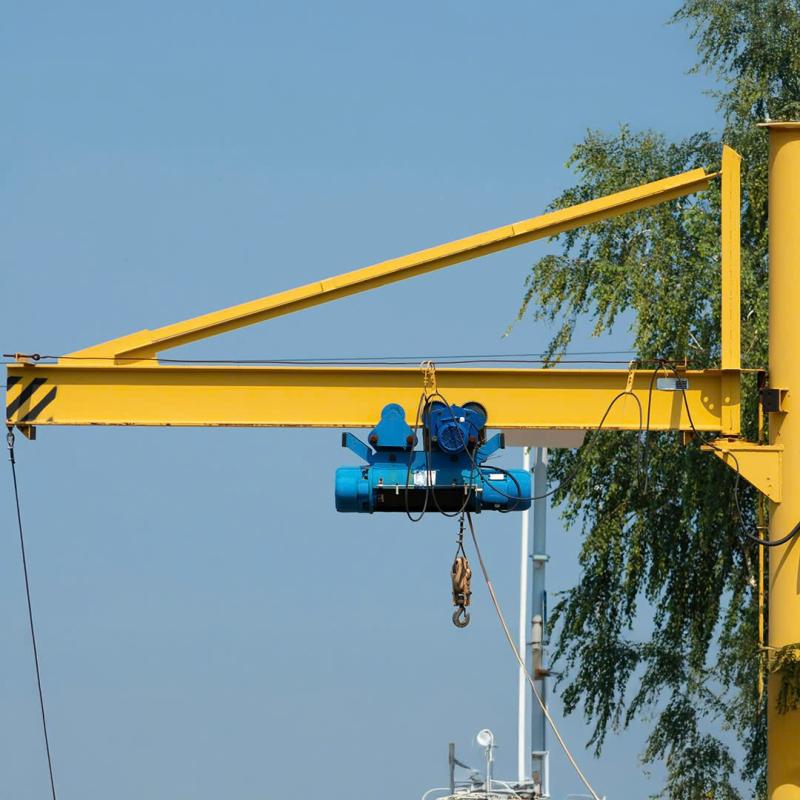



From assembly lines to loading bays, jib cranes provide localized, repetitive lifting capabilities that enhance productivity and reduce operator strain. However, improper installation or neglecting industry safety standards can result in operational failures, costly downtime, or severe accidents.
This guide explores the essential safety standards for installing freestanding, wall-mounted, ceiling-mounted, articulating, and pillar jib cranes, ensuring your facility complies with regulations while maximizing performance.
To review a full list of available models, explore the Jib Crane Categories.
 The Importance of Compliant Jib Crane Installation
The Importance of Compliant Jib Crane InstallationCompliance with safety standards is vital for:
Protecting personnel from harm
Ensuring equipment longevity and load integrity
Meeting insurance and legal obligations
Optimizing workflow efficiency
Whether you’re working with a wall-mounted jib crane in a compact workshop or an overhead ceiling-mounted jib crane in a warehouse, adherence to proper installation procedures and standards is critical.
Learn more about The importance of Jib Cranes solutions.
When installing jib cranes, it's essential to follow national and international safety codes, such as:
ASME B30.11 – Monorails and Underhung Cranes
OSHA 1910 Subpart N – Materials Handling and Storage
ANSI MH27.1 – Safety requirements for jib cranes
Manufacturer-specific manuals and technical specs
Each standard provides guidance on load testing, structural supports, rotation limits, anchoring, and periodic inspections.
Before installing any jib crane, ensure the mounting surface can withstand both vertical and horizontal forces during operation.
Freestanding jib cranes require concrete pads typically 150mm thick or more, reinforced with rebar.
Wall-mounted and pillar jib cranes must be attached to structural members capable of supporting maximum moment load.
Consult engineering drawings and if needed, a structural engineer.
Use only manufacturer-approved anchor bolts. The anchoring system should:
Resist vertical tension, horizontal shear, and torsional force
Be torqued according to manufacturer specifications
Be installed after concrete has fully cured (28 days typically)
Freestanding cranes offer 360° rotation and are ideal for open floor areas. Safety tips:
Always check baseplate level and foundation strength
Use seismic anchoring systems in earthquake-prone zones
Install barricades or warning lines to define swing radius
Wall-mounted models like the wall-mounted jib cranes require reinforced walls.
Use through-bolts with backing plates instead of lag bolts
Ensure clearance for the boom’s swing radius
Avoid installing near doorways or aisles with foot traffic
These save floor space but require careful ceiling assessment.
Attach only to load-rated ceiling beams or trusses
Install vibration dampeners if mounted above sensitive areas
Verify that installation doesn’t interfere with HVAC, lighting, or sprinklers
Articulating types such as articulated jib cranes products feature two pivoting arms for greater flexibility.
Ensure both pivot arms rotate freely without contact
Use anti-collision bumpers where arms may meet equipment or walls
Check horizontal loading specs for each arm segment
These are fixed to structural pillars and commonly used in machining or welding stations.
Confirm the integrity of the column prior to anchoring
Avoid modifying building columns without a structural assessment
Use clamping brackets that evenly distribute loads
Explore the Difference between crane and jib cranes options to understand when to use each.
For a detailed walkthrough, visit the official guide: Explore how to install jib cranes
Site Preparation
Measure swing clearance and boom length
Identify obstructions (vents, columns, conveyors)
Foundation Verification
Conduct load testing on concrete
Confirm rebar spacing and depth
Component Inspection
Check for dents, cracks, weld defects
Inspect hoist and trolley components
Mounting and Leveling
Use precision levels and shims for mast verticality
Align boom at optimal height for operational reach
Operational Test and Load Certification
Conduct no-load test followed by 125% load test
Check for vibration, misalignment, deflection
Once installed, safety doesn't stop. Ongoing inspection and maintenance are essential.
| Component | Daily | Monthly | Annually |
|---|---|---|---|
| Hoist brake system | ✔ | ||
| Boom rotation bearings | ✔ | ||
| Electrical connections | ✔ | ||
| Anchor bolts & base | ✔ | ||
| Load test | ✔ |
Train all crane users on:
Load rating and limits
Swing path awareness
Emergency stop procedures
Daily visual inspections
Install signage for load limits and swing zones
Avoid side loading the boom
Never exceed rated capacity, even momentarily
Keep a maintenance logbook
Use wireless remote controls to enhance operator distance from the load
The successful operation of any jib crane—whether freestanding, wall-mounted, ceiling-mounted, or articulating—begins with a safe and compliant installation. By following established industry safety standards, understanding structural requirements, and implementing best practices, you can ensure efficient performance with minimized risk.
For guidance on choosing the right crane type, browse the complete Jib Crane Categories.
References
1. How to operate a Jib Cranes safely
3. Over brace jib crane wall mounted
5. Is a Jib Crane a Gantry Crane
6. Articulated Jib Crane Wall Mounted
8. Manual Counterbalance Crane
10. Over Braced Jib Crane Column Mounted
Sign up to receive the latest info on new Aardwolf products, special offers and more.
By signing up you agree to receive emails from Aardwolf with news, special offers, promotions and other information. You can unsubscribe at any time.